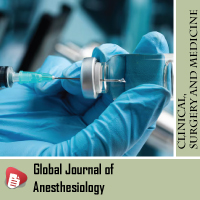Global Journal of Anesthesiology
Seizure-like Activity after Sedation with Propofol
Bilge Tuncer1, Şeyda Özkan1 and Ezgi Erkılıç1,2*
1Ankara Bilkent City Hospital, Turkey
2Department of Anesthesiology, University of Health Science, Turkey
Cite this as
Tuncer B, Özkan Ş, Erkılıç E. Seizure-like Activity after Sedation with Propofol. Glob J Anesth. 2024;11(1):007-008. Available from: 10.17352/2455-3476.000058Copyright
© 2024 Tuncer B, et al. This is an open-access article distributed under the terms of the Creative Commons Attribution License, which permits unrestricted use, distribution, and reproduction in any medium, provided the original author and source are credited.To the editor,
Propofol, an IV hypnotic with a modulating action on γ-aminobutyric acid receptors, is widely used for anesthesia and sedation during interventional procedures and in intensive care units. Favorable characteristics of propofol are the lack of accumulation and the relatively short recovery time.
However, propofol has adverse effects such as pain on injection, arterial hypotension, bradycardia, respiratory depression, and bloodstream infection [1]. Delayed neuroexcitatory symptoms after uneventful anesthesia are extremely rare. Neurological complications caused by propofol include generalized tonic-clonic seizures, focal motor seizures, increased tone with twitching and rhythmic movements, opisthotonus, and involuntary movements, collectively termed Seizure-Like Phenomenon (SLP).
In our gastroenterology department, we frequently use propofol in daily endoscopy and colonoscopy procedures. We would like to draw attention to SLP, a propofol-related complication we encountered.
A 27-year-old woman with asthma and hypothyroidism, receiving beta-blocker and levothyroxine treatment, was admitted for endoscopy for the etiology of anemia, in the Endoscopy Unit of Ankara Bilkent City Hospital. In her history, it was noted that, two years ago, she developed seizure-like activity after receiving anesthesia for fiberoptic bronchoscopy, and was intubated and extubated 1 hour later. EEG and CT results performed at that time were reported as normal. The patient was monitored before endoscopy and 20 mg lidocaine and 120 mg propofol were administered intravenously for sedation. There were no complications during the procedure and the procedure was completed successfully. The patient was admitted to the recovery unit and approximately 10 minutes after recovery, two episodes of confusion and seizure-like motor activity lasting 1-2 minutes, 10 minutes apart, were observed. The patient did not respond to verbal and painful stimuli during the neuroexcitatory symptoms manifested in the form of convulsions and tremors. Vital signs were stable during this period and 1 mg midazolam was administered intravenously. The patient who regained consciousness reported that she was conscious but unable to communicate and respond. After the procedure, the patient was taken to the intensive care unit and consultation was requested for neurological evaluation. Neurological examination was evaluated as normal and the patient had no further seizures during the follow-up period. After being treated in the intensive care unit on the first night, she was transferred to the ward and discharged. Informed consent was obtained from the patient for the publication of the data.
SLP is a rare but worrisome phenomenon with propofol. Seizure-like movements have been described in both surgical patients with epilepsy [1] and in those without a history of seizure or established risk factors for epilepsy. Although the pathophysiological mechanisms behind propofol-associated neuroexcitatory symptoms are not fully known, it has been suggested that it is associated with an imbalance between cortical and subcortical structures. Propofol is associated with central nervous system excitation via glycine antagonism occurring in subcortical structures [2]. Studies also suggest that propofol-induced paradoxical excitation may result from an interaction between γ-aminobutyric acid type A receptor and intrinsic membrane slow potassium current, which enables a switch from baseline interneuron synchrony to propofol-induced interneuron antisynchrony [3].
Propofol-induced SLP does not have any fixed pattern of occurrence concerning timing, duration, clinical presentation, age group, and the health of the patient involved [1]. Walder, et al. [1], in a systemic review, analyzed 81 cases of SLP, with predominance during induction, emergence, or delay after anesthesia and sedation. About 25% of cases of SLP attributed to propofol administration occurred following emergence [1]. The lower incidence of SLP during maintenance of anesthesia resulted from masking by neuromuscular blockage, a steady state level of propofol concentration, and less cerebral excitation [1]. In another study, 44 cases with propofol-associated severe neuroexcitatory symptoms were reported [4]. There was a female predominance of 2:1 and a median age of 27 years. It was reported that the onset of symptoms can be delayed, from 60 minutes to more than 6 hours after anesthesia and may last up to several weeks [4].
The diagnosis of SLP can be delayed owing to underrecognition. We conclude that health practitioners who frequently use propofol should be aware of this specific manifestation of drug toxicity and closely monitor their patients, particularly in outpatient settings.
- Walder B, Trame`r MR, Seeck M. Seizure-like phenomena and propofol: a systematic review. Neurology. 2002;58:1327-1332. Available from: https://doi.org/10.1212/WNL.58.9.1327
- Dolin SJ, Smith MB, Soar J, Morris PJ. Does glycine antagonism underlie the excitatory effects of methohexitone and propofol? Br J Anaesth. 1992;68:523-526. Available from: https://doi.org/10.1093/bja/68.5.523
- McCarthy MM, Brown EN, Kopell N. Potential network mechanisms mediating electroencephalographic beta rhythm changes during propofol-induced paradoxical excitation. J Neurosci. 2008;28:13488–504. Available from: https://doi.org/10.1523/jneurosci.3536-08.2008
- Islander G, Vinge E. Severe neuroexcitatory symptoms after anesthesia—with focus on propofol anesthesia. Acta Anaesthesiol Scand. 2000;44(2):144-149. Available from: https://doi.org/10.1034/j.1399-6576.2000.440203.x

Article Alerts
Subscribe to our articles alerts and stay tuned.
 This work is licensed under a Creative Commons Attribution 4.0 International License.
This work is licensed under a Creative Commons Attribution 4.0 International License.

 Save to Mendeley
Save to Mendeley
